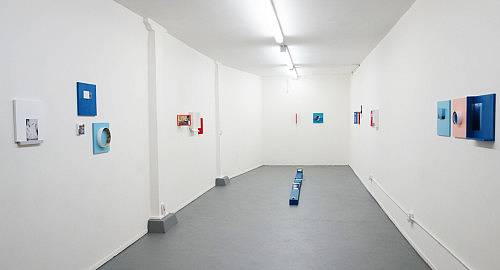Kate Bonner received her MFA from California College of the Arts in 2012. She lives and works in Oakland, CA. In 2013, Bonner was included in NextNewCA, a survey of select California MFA graduates at the San Jose Institute of Contemporary Art. She has exhibited at San Jose Institute for Contemporary Art, Torrance Art Museum, The Wattis Institute for Contemporary Art, Luis De Jesus Gallery, Et al Gallery, Queens Nails, The Popular Workshop, Important Projects, Paris Photo LA, and NADA New York, among others. She is represented by Luis De Jesus in Los Angeles and Et. al. in San Francisco.

Tell us a little bit about yourself and what you do. I grew up in multiple cities in Texas and Michigan. I’ve lived in Japan, Chicago, Brooklyn, San Francisco and now Oakland. Maybe it is because I have lived in so many cities, or because I was very shy when I was young, that I am interested in location and structural divisions and how they shape perspective.
Part photo, part sculpture, my work is an attempt to expand space and to bar entry. I use scissors, scanners, digital erasers and jigsaws to break apart images and deny story to the viewer.
My work uses representation but for abstract, formal reasons. I treat photographs as objects and sometimes use them as portals to break through the surface of the piece. My work values perceptual failures and contains real boundaries: literally walls, windows and frames that serve as entry points or that limit access.
What is one of the bigger challenges you and/or other artists are struggling with these days and how do you see it developing? In SF, it’s a high cost of living. So many good friends have left town, or dispersed to far corners of the bay area, and some good galleries have closed or relocated. To be fair, there are some great new galleries too. It is confusing: so many friends have relocated to LA, that when I visit LA its like I’m back in the San Francisco of three years ago.

How did your interest in art begin? I was always interested in drawing and photography. My great-grandmother was a photographer, and so were her parents. My grandparents gave me a manual camera when I was twelve, and I took hundreds of photos of distant, unremarkable landscapes, that looked even less remarkable as glossy 3x5s. In Texas, a neighbor taught me to make blind figure-line drawings. College was the first time I encountered contemporary art, the first time I heard terms like installation or conceptual or performance. I took an art elective my first semester and switched my major to art.
If you had to explain your work to a stranger, what would you say? I say that it is part photo, part sculpture, and sometimes I briefly describe my materials or process and leave it at that. I prefer to show pictures.

What materials do you use in your work and what is your process like? I create many, many more images than I’ll ever use. I look for photographs and objects that are not iconic, that I can cut apart and scan. I use digital drawing apps or Adobe Creative Suite programs to manipulate scans and cell phone pictures. I build digital documents with multiple layers and I use paintbrush or eraser tools to add or edit content. Sometimes images inspire the form, and sometimes I decide on a form first and then find or create an image. Sometimes my ideas are born out of material research. I’m learning to use a CNC router now, and some of my mistakes are leading to new ideas. Conversely, many of my ideas aren’t possible yet, and so I am researching new techniques or processes that might make them possible.
What artists are you interested in right now? I really love the work of Lisa Williamson, Ian Kiaer, Franz West, and Charles Long.

What’s your favorite thing about your city? Oakland is always sunny. And it is flat and easy to navigate by bicycle. There is a lot going on in terms of art and music, and yet, unlike NY, it is so easy to get out of town and into some amazingly beautiful and remote locations.
Other than the escalating rent, this is a good town for emerging artists: it’s on the international radar, but it’s small and supportive.

What was the last exhibition you saw that stuck out to you? Matti Kallionen‘s show at Christian Larsen in Stockholm frightened me at first, and then I was caught up in experience of it. I also enjoyed the theatrics of Pierre Huyghe’s show at LACMA and I appreciated how the show unraveled and revealed itself over the length of time that I spent in the space.
Currently, locally, I’m enjoying the subtlety of paintings by Chris Hood and Andrew Chapman in “An arbitrary group of paintings” at Et. al.

What do you do when you’re not working on art? I work part-time at a printing press. Otherwise I like to spend my free-time reading fiction, or hiking and camping and seeking out natural hot springs.
If you hadn’t become an artist what do you think you’d be doing? Someday, when I find time, I hope to learn to build cabinetry and furniture.
What are you listening to right now? Dean Blunt, Paradis and Roberto Cacciapolia’s Ann Steel Album and podcasts, like Song Exploder or Alec Baldwin’s Here’s the Thing.

